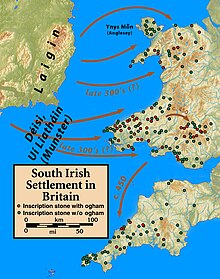Déisi

The Déisi were a group of people in ancient Ireland . The old Irish term is derived from déis, which means vassal . Originally, it referred to groups that were vassals or tenants of a landowner. It later became a proper name for certain groups and their subjects across Ireland. The peoples listed under "déis" had the same status as clans in Ireland. They had little or no actual kinship, even though they were considered related.
Among the deisi groups of Ireland, the deisi Muman included (deisi of Munster), which deisi Temro (deisi of Tara), which deisi Becc (deisi in the Kingdom of Mide) and the deisi Tuisceart (northern deisi whose group Dál gCais by Brian Boru famous has been). During the early Middle Ages, some deisi groups exercised great political influence in different parts of Ireland. In the Kingdom of Munster, the Déisi were long under the hegemony of the Eóganachta.
During the late 4th and early 5th centuries, a large group of Uí Liatháin from Munster and especially from Déisi moved from Ireland to Great Britain and settled in Wales , Cornwall and the Isle of Man . They ousted the ruling Demetae in South Wales and founded the kingdoms of Dyfed ( Welsh Deheubarth ) and Brycheiniog .
The historicity of the conquest is supported by a family tree preserved in Harle's ancestral books of the late 10th century, in which the contemporary kings of Dyfed claim to be descended from Triphun, a great-grandson of Eochaid Allmuir. Although the presence of the "Déisi" in Dyfed is historical, it remains unclear whether it is a large-scale migration or a dynastic transfer or both. The study shows that it could not have taken place at the time mentioned in the medieval story of the expulsion of the Déisi (after the blindness of Cormac mac Airt , traditionally in AD 265), but at the earliest in the second half of the 4th century. A beginning in the sub-Roman times at the beginning of the 5th century cannot be ruled out. The Ogham stones of Wales are evidence of Irish influence.
Today na Déise ( Anglicised Decies ) is understood to mean the area of County Waterford with the small Irish-speaking area ( Gaeltacht ) Gaeltacht na nDéise located there .
literature
- Bruce Coplestone-Crow: The Dual Nature of Irish Colonization of Dyfed in the Dark Ages . Studia Celtica. 16/17 (1981/82). Pp. 1-24.
- John V. Kelleher: The Rise of the Dál Cais , In: Étienne Rynne (ed.), North Munster Studies: Essays in Commemoration of Monsignor Michael Moloney. Limerick: Thomond Archaeological Society. 1967. pp. 230-41.
- Kuno Meyer (Ed.): The Expulsion of the Dessi . Y Cymmrodor. 14: 1901 pp. 101-135.
- Tomás Ó Cathasaigh: The Déisi and Dyfed . Eigse. 20: 1984 pp. 1-33.
Individual evidence
- ↑ The Expulsion of the Déisi is a medieval tale of the Cycles of the Kings (Cycles of the Kings). It dates from around the 8th century, but only survived in later manuscripts. It tells the fictional story of the Déisi Muman, who gained political power in parts of Ireland during the early Middle Ages. In particular, one passage describes a UK-based Déisi branch and the establishment of the Kingdom of Dyfed, which is of interest in the context of early Irish migrations to the UK.
